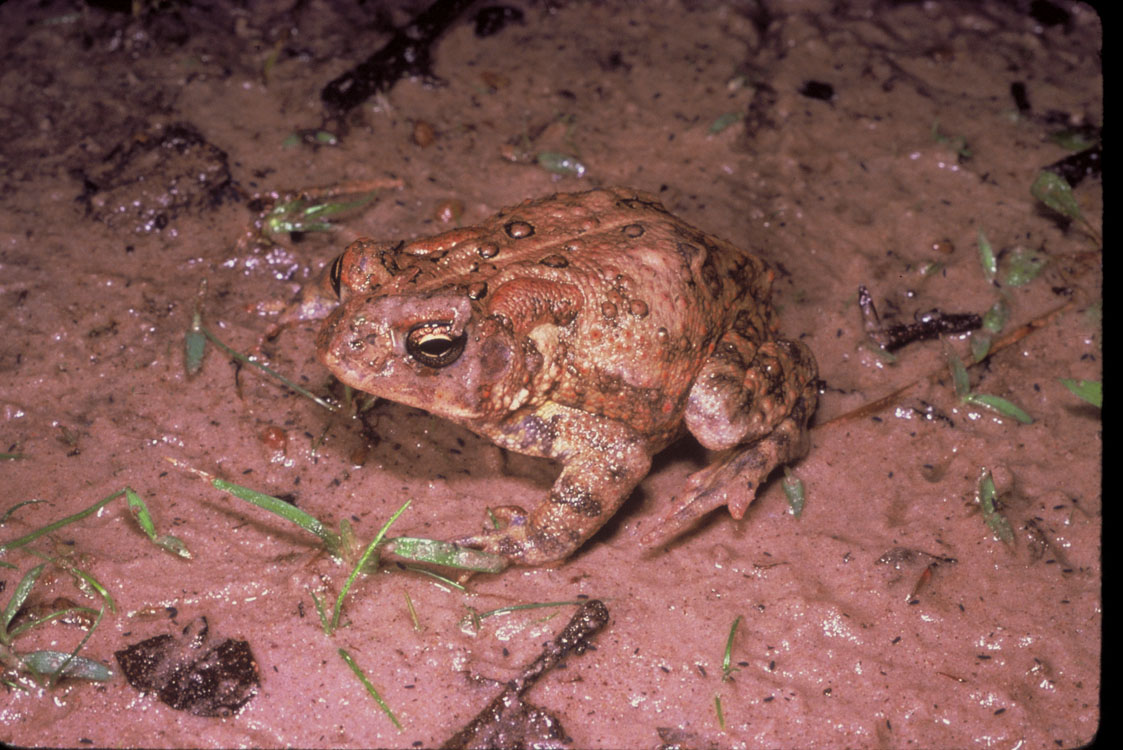- Houston toad
Taxobox
name = Houston toad
status = EN | status_system = IUCN3.1
trend = down

image_width = 240px
regnum =Animalia
phylum = Chordata
classis =Amphibia
ordo =Anura
familia =Bufonidae
genus = "Bufo "
species = "B. houstonensis"
binomial = "Bufo houstonensis"
binomial_authority = Sanders, 1953
synonyms = "Anaxyrus houstonensis"The Houston toad ("Bufo houstonensis") is anendangered species ofamphibian . Thetoad was discovered in the late 1940s and named in 1953. Official estimates are that just 3,000 - 4,000 adult Houston Toads are left in the world.Characteristics
The male Houston toad grows to 2-3.5 inches when mature with the female being larger and bulkier. Although generally brown and speckled, their color can range from black to purplish gray, sometimes with green patches. The toads typically live 2-3 years, and need sandy, loose soil to burrow in for protection from the cold in the winter and the hot, dry conditions of the summer. The toads are
nocturnal and feed on insects and small invertebrates.During February and March, the male emits a high clear trill by distending a vocal sac on its throat, in hopes of attracting a mate. A female will choose a male based on certain characteristics of his call. Small isolated pools and ponds are the toad's main breeding ground. A female toad will lay several thousand eggs in long single-egg strands that are fertilized externally by the male as they are laid. The eggs hatch within seven days and tadpoles take between 15-100 days to turn into little toads, which leave the breeding pond and begin to forage on land. They toadlets eat mostly
ant s,beetle s andmoth s.They move by making short hops. Since they cannot usually out run their
predator s such asspider s,snake s,turtle s,owl s,raccoon s, and otherfrog s, the toads have developed coloration and rough skin tocamouflage themselves. Also, their skin secretes chemicals that are distasteful, and sometimes poisonous, to predators. In addition to protecting the Houston toad from being eaten, some of these chemicals have proven useful medicines to treat heart and nervous disorders in humans.Habitat and range
The Houston toad today, lives exclusively in
pine or mixed hardwood andoak forests. It is possible, but unsubstantiated, that it historically occurred insavanna among native bunchgrasses and flowering plants. The toad's original range covered 12 counties in Texas; currently, it is often reported to occur in nine counties. However, choruses have only been actually reported in three counties since 2000, representing a seventy-five percent overall reduction in twenty years.Preservation
In 1970, the Houston toad was federally listed as an endangered species. It was extirpatedfrom the
Houston, Texas area by the 1960s, likely coincident with the severe drought of the 1950s and concurrent development of its forested habitat in that region. Though the largest and most immediate threat is habitat loss, the reduced toad populations are also vulnerable toautomobile s, predators,pesticide s anddrought .The largest known chorusing groups persist in Bastrop County, but the choruses monitored in
Bastrop State Park showed a dramatic decline during the mid-1990s, with little recovery of those numbers since then. Importantly, that state park is the only public land that supports consistent chorusing from year to year of the Houston toad. However, even there, the total numbers are very low.Conservation groups are working with private landowners in Bastrop County to protect and restore Houston toad habitat, but even if recovery were to be achieved in Bastrop County, this effort would not have achieved recovery for the species. Efforts toward active conservation efforts in the remaining Houston toad occupied counties and even efforts within counties from which the toad has been extirpated are needed.
References
* (1984) Reproductive ecology and hybridization of the endangered Houston toad ("Bufo houstonensis"). "Journal of Herpetology" "18": 56–72.
* Database entry includes a range map, a brief justification of why this species is endangered, and the criteria used
*"Houston Toad". [http://www.environmentaldefense.org/documents/3737_Species_Houston%20Toad.pdf Environmental Defense] . Retrieved Nov. 17, 2005.
*"The Endangered Houston Toad". [http://www.fws.gov/ifw2es/HoustonToad/ U.S. Fish & Wildlife Service] . Retrieved Nov. 17, 2005.
* (2004) The history of a Nearctic colonization: Molecular phylogenetics and biogeography of the Nearctic toads ("Bufo"). "Evolution" "58": 2517–2535.
Wikimedia Foundation. 2010.
